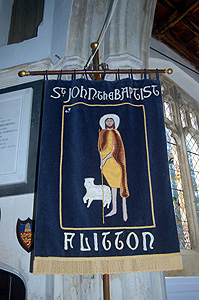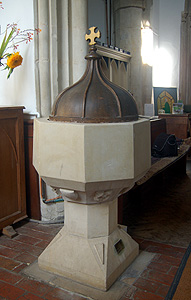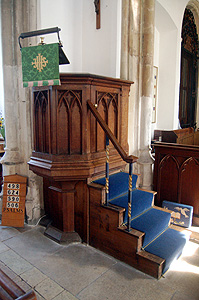List of Flitton Vicars

The vexillum August 2011
The Advowson
Volume II of The Victoria County History for Bedfordshire, published in 1908 gives a brief history of the advowson of the church of Saint John the Baptist, Flitton. The advowson belonged to Elstow Abbey by the late 12th century and was held until the abbey was dissolved by King Henry VIII in 1536. In the year the abbess of Elstow had leased the advowson to Thomas Hile of Silsoe [L5/1079]. Dunstable Priory had claimed the right but the dispute, which occurred at some point between 1159 and 1181 was settled in Elstow's favour by Pope Alexander III.
After the Dissolution the Crown held the advowson until 1546 when it was given to the Dean and Chapter of Christ Church College, Oxford. The Earls of Kent held the advowson on a lease from the college from at least 1606 as they leased out the vicarage at that date [L5/1080]. Their successors, the Earls de Grey and Barons Lucas of Crudwell seem to have continued the practice until at least 1908. Since 1920 Flitton has been held in plurality with Pulloxhill and, since 1967 also with Silsoe and the right to present the vicar is shared between the Bishop of Saint Albans and Balliol College, Oxford. each parish retains its own parochial church council, churchwardens and service times but they share a priest.

The font August 2011
List of Vicars
The following list of Vicars of Flitton is as complete as records will allow.
- Henry de Hattell: chaplain; 1235;
- Robert: deacon; on the death of Henry last Vicar: 1260;
- Reginald;
- Robert de Hicch: priest; on the death of Reginald; 15th January 1279;
- John Maurieij: chaplain; on the death of Robert de Hoggele: 16th May 1308;
- John Ghissop;
- John le Deister: Rector of Childecomb in the Diocese of Winchester by exchange with John of Ghissop: 31st March 1341;
- William le Messuag of Stamford, priest; on the resignation of John Deystere: 28th July 1346;
- Henry de Shrynton: priest; on the death of William: 4th July 1439;
- John Fyndel – 27th Apr 1350 [priest; on the resignation of Henry: 27th April 1350;
- William Tappe: priest: 11th September 1394;
- Robert Merston: priest; on exchange with William Tappe; 10th April 1409;
- William Skynnere: priest; on the resignation of Robert Merston, who exchanged to be Vicar of Corby [Northamptonshire]: 9th October 1409;
- Robert Merston: chaplain; on the resignation of William Skynnere, who exchanged to be Vicar of Corby: 15th February 1410;
- Nicholas Throndeston;
- Robert Merston – 31st Jan 1418 [Vicar of Middleton [Northamptonshire] in the Diocese of Ely; on exchange with Nicholas Throndeston: 31st January 1419;
- John Kyrkeby: chaplain; 2nd Aug 1419;
- John Aldham: priest; on resignation of Robert Kyrkeby; 29th October 1420;
- William Edenham: late a monk of Vawey; on the resignation of John Aldham: 24th September 1422;
- William Launder;
- Richard Michell: priest; on the death of William Launder: 10th October 1443;
- William Lyngfeld: 22nd July 1443
- Henry Byllok: priest; on the death of Richard Mechell: 6th May 1444;
- Edmond Bryon: priest; on the resignation of Henry Byllock; 20th March 1445
- William atte Fenne: priest; on the resignation of Edmund Byron: 5thNovember 1445;
- Robert Drury: priest; on the death of William Fenne: 31 July 1457;
- Robert Drury: vacant; 6 February 1473;
- Richard Bysshop: on the death of Robert Drury, last vicar; 22nd April 1477;
- Richard Purser: priest; on the death of Richard Bisshop; 8th May 1484;
- Richard Kyrke: priest; on the resignation of Richard Purser; 10 September 1492;
- Roger Bullock: priest; on the death of Richard Kyrke: 8 November 1504;
- Henry Richardes: on the death of Roger Bulloke: 30thSeptember 1517;
- Edward Philipe: B.A.; on the resignation of Henry Richardes: 11 January 1533;
- John Gale: chaplain; on the resignation of Edward Philipe: 1 September 1541;
- Richard Wilson: clerk; on the resignation of John Gale: 14th May 1551;
- William Broke: clerk: 4th July 1554;
- Henry Coleman: 28th March 1555;
- Ludovic Price: clerk; on the death of the last Rector: 1555;
- Thomas Falle: B.A.; He married Judith Hill and was buried 2nd October 1600; his will is dated 2nd April 1599 and proved 2nd May 1601: 12th November 1580;
- Richard Wood: [B.A.; on the death of the last incumbent: 9th February 1601;
- Reynold Burden;
- Thomas Paxton: 4th Jul 1622;
- William Ramsey: he married Ann Wilward; 16th May 1629 to 1645 when deprived;
- John Gardner: 1647-1655 when he was ejected;
- William Harris: deacon; M.A.; on the death of the last vicar: 20th September 1665;
- William Cauldwell: B.A.; on the death of William Harris; he married Mrs Sanderson at Pulloxhill on 17th November 1709 and was buried on 21st July 1722: 17th August 1686;
- John Birt: B.A.; on the death of William Cauldwell: 20th September 1722;
- Philip Birt;
- Hadley Cox: M.A.; on the death of Philip Birt: 20th January 1763;
- Edward Auriol Drummond: M.A.; on the death of Hadley Cox; 30th July 1782;
- John Robinson: M.A.; on the cessation of Edward A. Drummond; died 12th October 1817: 12thMay 1784;
- John Thomas James: M.A.; on the death of John Robinson: 9th March 1818;
- Henry Wellesley: M.A.; on the resignation of John Thomas James: 5th September 1827;
- Alfred Browne: M.A.; on the cessation of Henry Wellesley: 18 March 1834;
- George Renaud: 1876;
- James W. Sawyer: M.A.; on the resignation of George Renaud: 1883;
- John Draper: February 1907;
- Arthur Crean: November 1911;
- H. E. Roberts: October 1917;
- Alfred Ernest Houfe: 1920;
- William Steele Dobson: April 1931;
- Frederick A. Johnson: 1945;
- Frank M. Eagles: 1954;
- Reginald Burman: 1961;
- Peter John Millam: 1970;
- Bernard Lawrence Nixon: 1982;
- Stephen C. Holroyd: 1997.

Tripytch on the south wall of the south aisle August 2001
Civil War Troubles
The Victoria County History, Volume II, page 332 gives some interesting information about the vicars during the Civil Wars: "The Committee for Plundered Ministers increased the value of the living in 1646 ... The vicar at this time was one William Ramsey, instituted in 1628, who on 17th January 1645, was summoned to appear the following April before the Committee of Plundered Ministers at Westminster, to answer a charge of drunkenness; he failed to appear, and, on 11th May 1647, was proved to be a common drunkard". It is interesting to note that the Earl of Kent at this time, Henry, 10th Earl, was Speaker of the House of Lords in 1645 and from 1647 to 1649 and firm supporter of Parliament in its civil war with the King. He dd not have the advowson of Flitton but he would surely have known the vicar well and probably ensured his fate.
The Victoria County History goes on: "In 1655 the vicar was ejected for refusing to conform to the standards of Presbyterianism, but nevertheless he maintained an obstinate resistance, and for a long time remained in the parsonage". By this time the Earl of Kent was Anthony, the 11th Earl, then a child of ten, his mother, "the Good Countess" being manager of the Wrest Park estate in his minority. She acquired the lease of the advowson in 1656 and perhaps she encouraged the vicar in his resistance.

Bishop's chair August 2011
Visitations
Volume 81 published by the Bedfordshire Historical Records Society (2002) is devoted to returns made during episcopal visitations to the county by the Bishop of Lincoln in the early 18th century, edited by former County Archivist Patricia Bell. It throws some interesting light on non-residency and the general state of the church in the parish. At this date it was common for a rector or vicar to not live in the parish he nominally served, often because he had more than one, and so employed a curate to undertake their parochial duties for him. Flitton seems an exception to this. The returns for Flitton are as follows:
- 1706: The Value of the Vicarege [sic] is about £40: Flitton £17 per Annum and Silso [sic] £23, where the Vicar preaches every Sunday in the Afternoon.
- 1709: None who come to Church Unbaptized. Few of years to be confirmed want Confirmation. Communicants 200, of which 70 received at Easter last. There are many if Age, who seldom or never Communicate at all.
- 1712: The Vicar resides, and has part of the Vicarege [sic] House in his hands, but for want of conveniences in it, lives in another. One not baptized comes to Church. Severall [sic] not Confirmed. Divine Service twice every Lord's day, once upon Litany and Holy-days. Communion 8 times a year. Of 300 communicants about 80 received at Easter. The Communion refused to One, a very Ill Woman".
- I do reside personally upon my Cure, but not in my Vicarage House. I have no Curate. I know of but one who comes to Church that has not been baptized. I have baptized no adults since the last Episcopal Visitation. The publick [sic] service is duly performed twice every Lord's Day; once in the Parish Church of Flitton and once in the Chappell [sic] at Silso [sic]. The Sacrament of the Lord's Supper is administered four times a year at Flitton and as often at Silso. We have about two hundred and fifty Communicants in the Parish; about seventy usually receive, at Easter last about Eighty.
- 1720: I reside upon my Cure but not in my Vicarage House, it being not convenient for my Family. I have no Curate. Unbaptized I know of none. The publick [sic] service is perform'd every Lords Day in our Parish church and twice a month in Silso [sic] chapel which is in the same Parish. Sacrament Four times a year. We have about two hundred Communicants. About sixty received at Easter and about fifty usually receive.

The pulpit August 2011
Ecclesiastical Census
On Sunday 30th March 1851 a census of all churches, chapels and preaching-houses of every denomination was undertaken in England and Wales. The local results were published by Bedfordshire Historical Records Society in 1975 as Volume 54, edited by D.W.Bushby. The return for Flitton church was made by the , who noted the following pieces of information:
- 60 general congregation in the morning and 60 in the afternoon;
- 35 Sunday scholars in the morning and 35 in the afternoon
- "The above is the average number attending Church".
![Greenfield School about 1900 [Z50/49/1]](/CommunityHistories/Greenfield/GreenfieldImages/Greenfield School about 1900 [Z50-49-1].jpg)
Greenfield School about 1900 [Z50/49/1]
Greenfield
Until 1984 the northern part of the High Street and Flitton Road in Greenfield was in the parish of Flitton, the southern side being in Pulloxhill. It is quite some way to the church in either village from Greenfield and at the end of the 19th century an attempt was made to rectify that. Kelly's Directory for Bedfordshire for 1894 and 1898 notes: "Divine service is conducted in the schoolroom at Greenfield".